- Finnhub: Offers U.S. equity options data, including bid/ask prices, volume, and implied volatility. Free and paid plans available with API integration.
- OptionMetrics: Focuses on global options markets with daily and intraday data. Ideal for institutional clients with custom pricing.
- Databento: Provides tick-level options data with flexible pay-per-use or subscription models. Includes APIs for high-frequency trading.
- EOD Historical Data: U.S.-focused options data with end-of-day summaries. Affordable subscription plans and API support.
- Polygon.io: U.S. options data with real-time feeds and granular details. Offers tiered pricing, starting with a free plan.
- Marketstack: Primarily covers equities and commodities. Limited options data but suitable for basic research with subscription tiers.
- Stock Analysis: A free platform for U.S. stock data. Minimal options coverage and no API support.
Quick Comparison
| Provider | Options Data | Granularity | Pricing | API Access | Best For |
|---|---|---|---|---|---|
| Finnhub | U.S. equity options | Tick, minute, daily | Free & Paid Plans | Yes (REST API) | Automated trading |
| OptionMetrics | Global options markets | Daily, intraday | Custom Pricing | Yes (Institutional) | Academic & institutional |
| Databento | U.S. equity options | Tick-level, high-frequency | Pay-per-use & Subscriptions | Yes | High-frequency trading |
| EOD Historical Data | U.S. options | End-of-day, intraday | Subscription-based | Yes (REST API) | Small-scale research |
| Polygon.io | U.S. options | Tick, minute, second | Free & Paid Plans | Yes (REST API) | Developers & medium-scale |
| Marketstack | Limited options data | End-of-day, intraday | Subscription-based | Yes (REST API) | Basic research |
| Stock Analysis | Minimal options data | Basic price history | Free | No | Manual research |
Takeaway
Choose a provider based on your needs: Finnhub and Polygon.io are great for developers; OptionMetrics suits institutional users; Databento is ideal for high-frequency trading; and EOD Historical Data offers cost-effective options for small-scale projects.
Can I Find Historical Data On Past Options Symbols? – Stock and Options Playbook
1. Finnhub
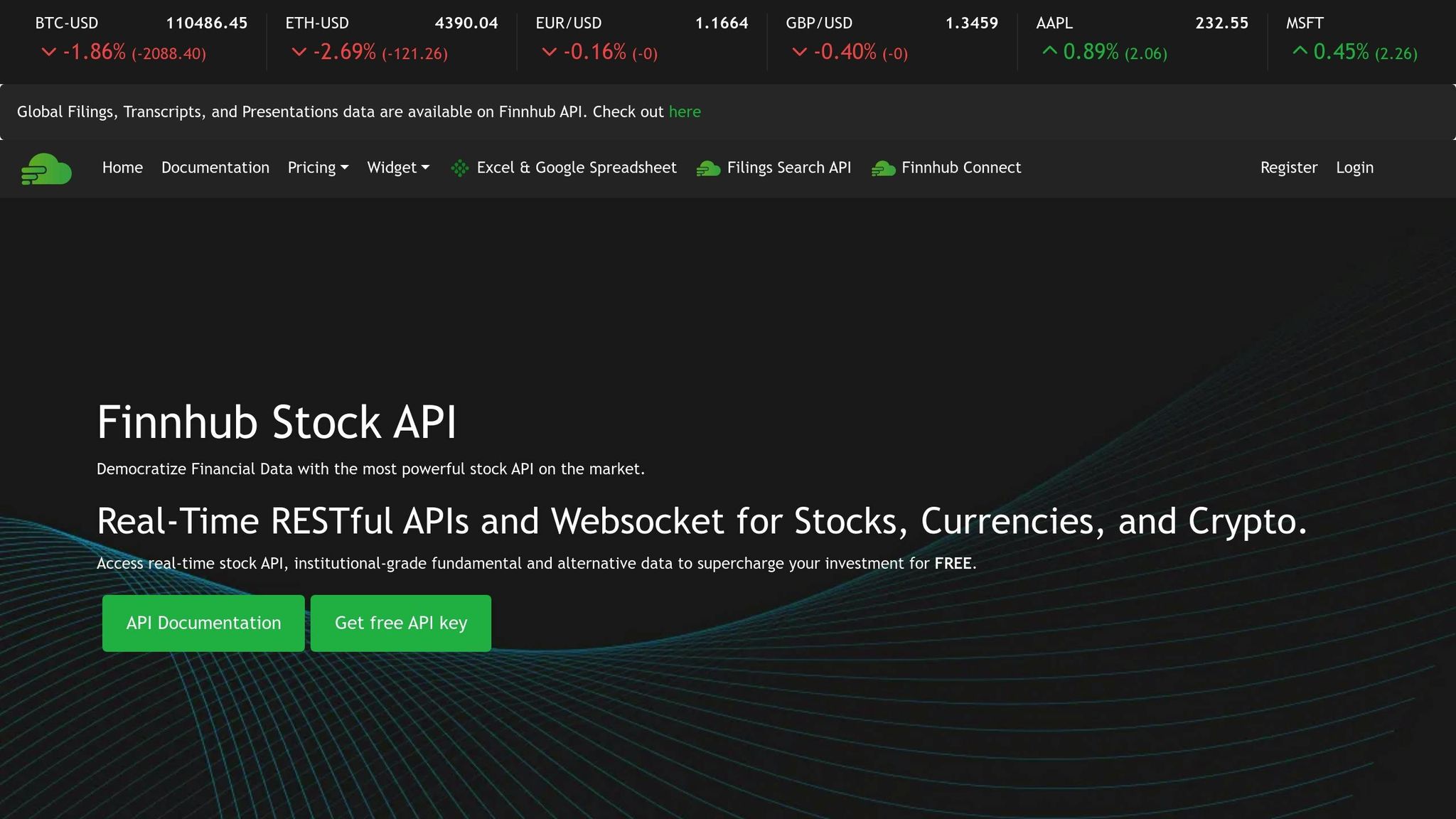
Finnhub stands out as a robust resource for historical options data, designed to support backtesting and strategy development.
Data Coverage
The platform focuses on US equity options, spanning stocks, ETFs, and major indices. It provides essential metrics like bid/ask prices, volume, open interest, and implied volatility. What’s more, Finnhub archives expired contracts, making it a valuable tool for in-depth backtesting.
Granularity
With both end-of-day and intraday options data, Finnhub allows users to track price changes and risk dynamics. This level of detail is especially useful for analyzing market behavior during key events.
Pricing Structure
Finnhub offers a tiered subscription system. It includes a free plan for basic access, while its Professional and Enterprise plans cater to users with more advanced requirements.
Accessibility and Integration
Finnhub makes data integration simple with its RESTful API, supported by detailed documentation and client libraries. Data can be exported in JSON or CSV formats, ensuring compatibility with various workflows. Up next, we’ll explore another top-tier options data provider.
2. OptionMetrics
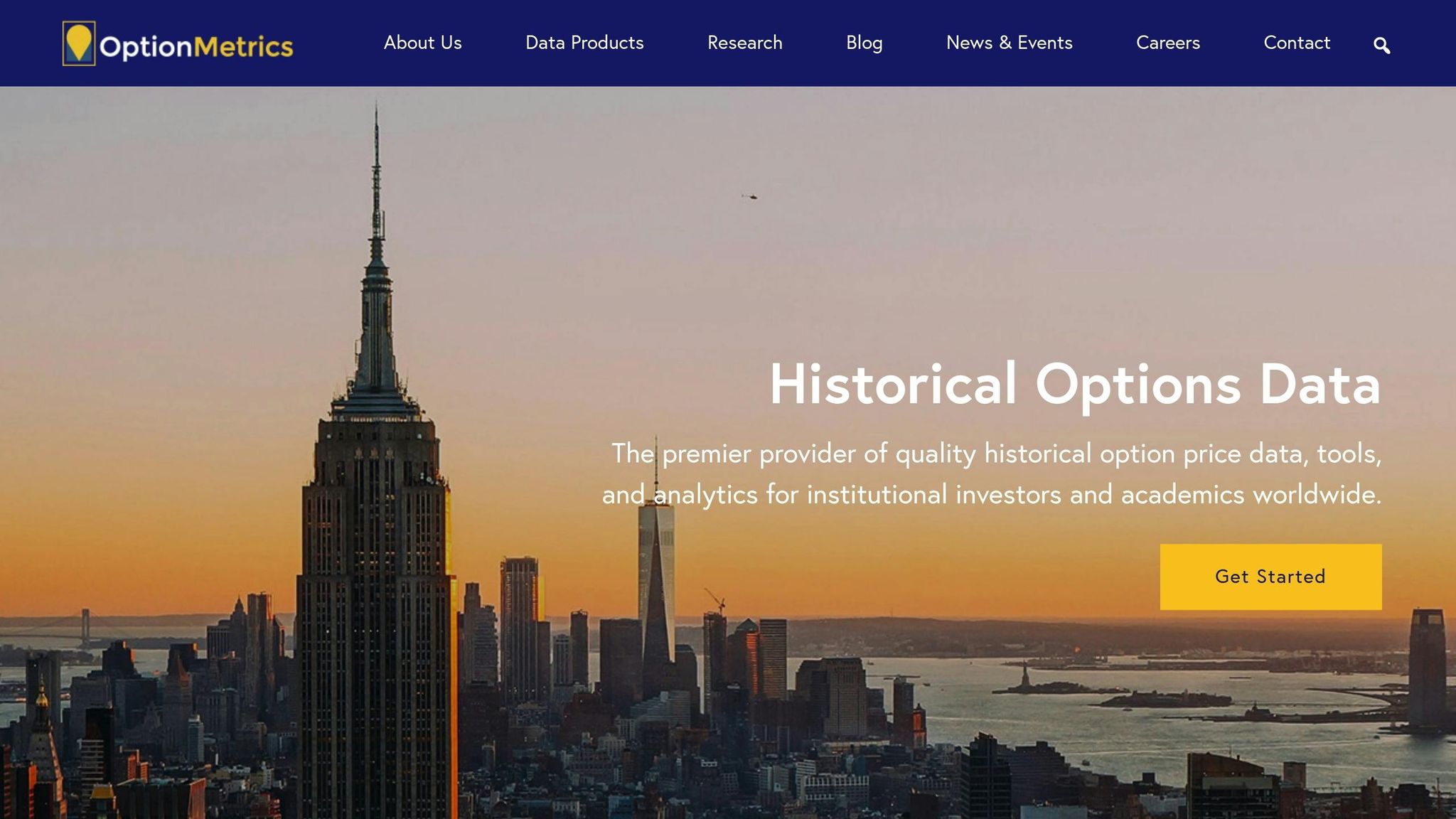
OptionMetrics delivers historical options data tailored for hedge funds, academic researchers, and financial institutions globally.
Data Coverage
This platform provides end-of-day options data for markets worldwide, including the United States, Europe, Asia-Pacific, and Canada. Their datasets feature accurate option prices, calculated implied volatilities, Greeks, and daily high, low, and closing prices for underlying equities and indices. Additional data points include interest rates, dividend information, and corporate actions – critical components for thorough financial analysis.
Granularity
Originally focused on end-of-day data, OptionMetrics has expanded to include intraday snapshots. On August 20, 2025, they introduced IvyDB US – Intraday, offering options data captured at three specific times during the trading day: 10:00 a.m., 2:00 p.m., and 3:45 p.m. ET.
"OptionMetrics is excited to announce the launch of IvyDB US – Intraday, providing institutional investors, hedge funds, and academic researchers with high-quality intraday options data at 10:00 a.m., 2:00 p.m., and 3:45 p.m. ET."
Additionally, their IvyDB Signed Volume product delivers intraday trading volume data in five- and 30-minute intervals, complementing their end-of-day datasets. This increased granularity is paired with a flexible pricing model to meet diverse client needs.
Pricing Structure
OptionMetrics employs a bespoke pricing approach, with rates tailored to each client. Costs depend on factors such as the number and complexity of instruments (ranging from 150 to over 15,000 securities), the intended use across teams and locations, the level of client support required, and redistribution rights. This structure is designed to accommodate the needs of institutional clients.
Accessibility and Integration
The platform primarily serves institutional clients through direct data feeds. Academic users, however, can access OptionMetrics datasets via platforms like Wharton Research Data Services (WRDS), ensuring broad usability across different sectors.
3. Databento
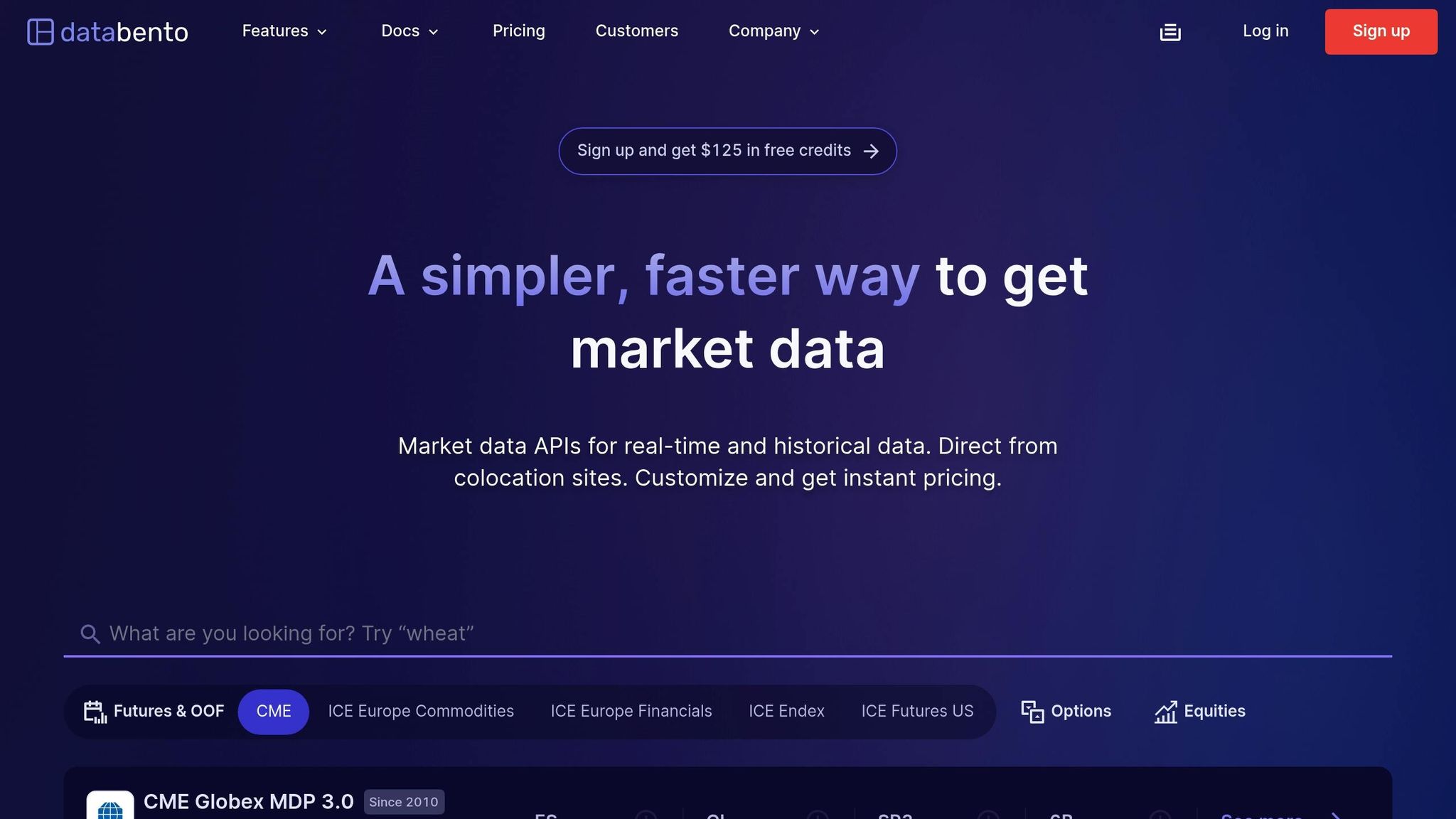
Databento offers historical options data tailored for quantitative traders and researchers, using a pricing model designed to adapt to various needs.
Pricing Structure
Databento uses a dual pricing system with two main options: pay-per-use and subscription plans. As highlighted by Databento:
"Flexible pricing: Only pay for what you use, or get unlimited access with a subscription plan."
For those opting for subscriptions, there are three tiers available:
- Standard: $199/month
- Plus
- Unlimited
Each plan includes free historical data (depending on the schema) and unlimited access to live data. To help new users get started, Databento offers $125 in free credits, which can be used toward purchasing historical data or subscribing to a plan.
While Databento recently updated its approach to live data, it has retained its commitment to usage-based pricing for historical data:
"Although we’ll no longer support usage-based live data, pay-as-you-go pricing for historical data will remain one of Databento’s core features. Usage-based historical data is not being removed."
Next, let’s take a closer look at EOD Historical Data for more options.
4. EOD Historical Data
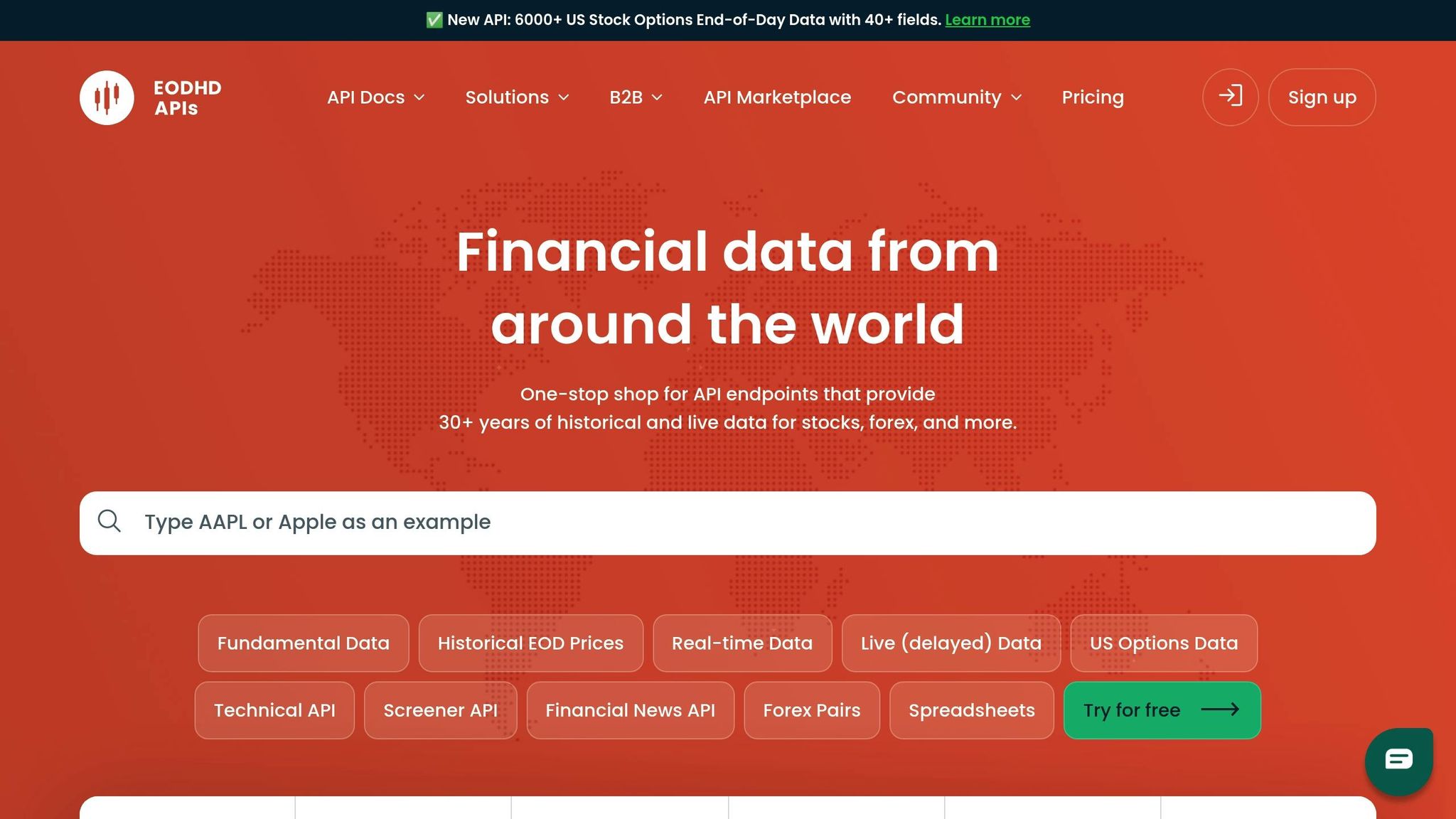
EOD Historical Data offers historical options data specifically for the U.S. stock market. This data is a valuable resource for traders looking to backtest their strategies with confidence.
Pricing Structure
EOD Historical Data operates on a subscription-based model. The pricing is designed to be flexible, allowing users to adjust their plans without long-term commitments as their data requirements change.
Up next, let’s take a look at what Polygon.io has to offer.
5. Polygon.io
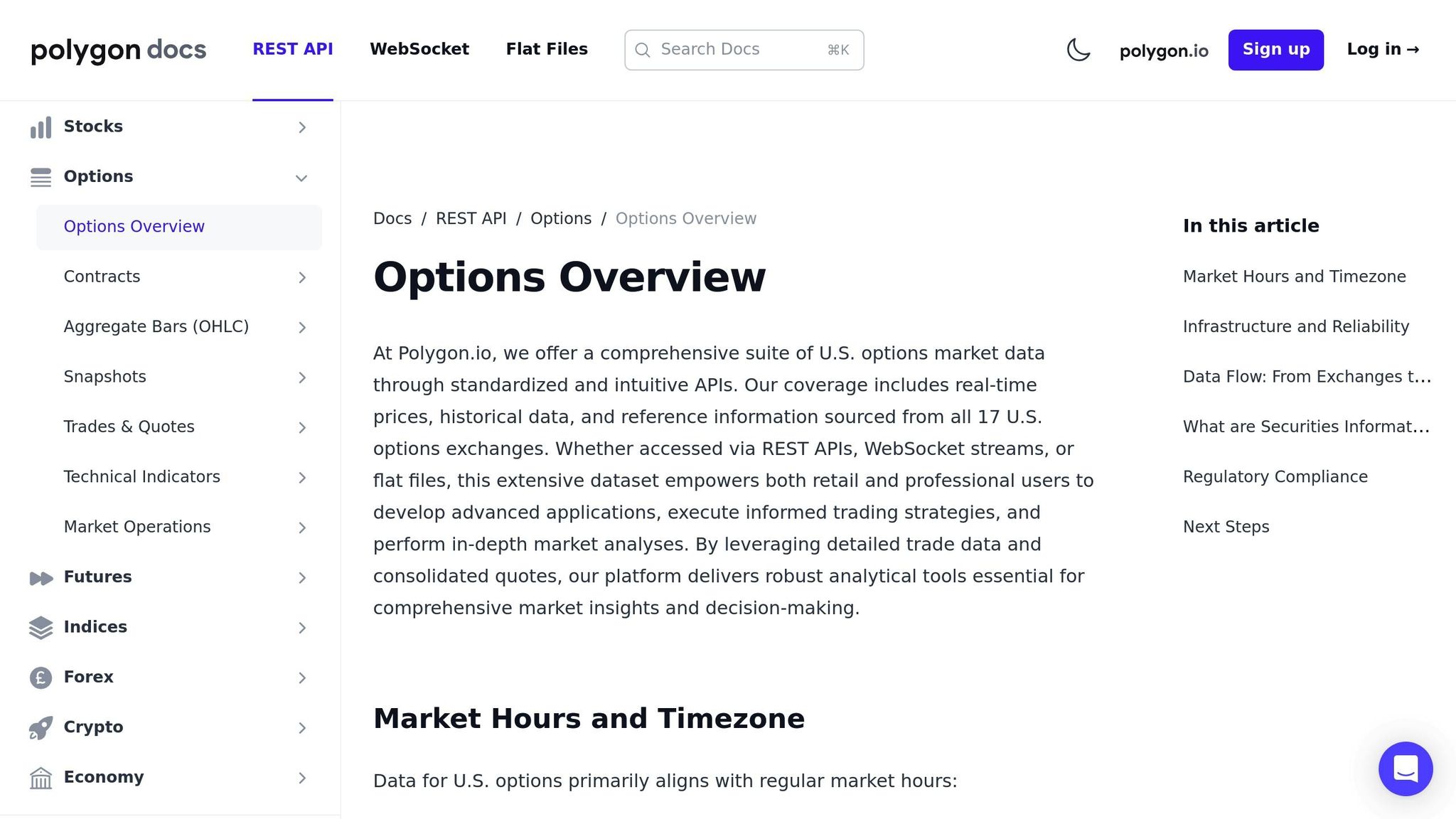
Polygon.io offers an extensive range of U.S. historical options data through a tiered subscription model, catering to both individual traders and institutional clients.
Data Coverage
Polygon.io specializes in U.S. historical options data, covering a broad spectrum of equity options. This makes it a valuable resource for quantitative analysts and traders conducting backtesting or research in American options markets.
Granularity
The platform provides data with varying levels of detail, including end-of-day summaries, intraday aggregates (minute and second), and even tick-level data. The level of granularity available depends on the chosen subscription plan.
Pricing Structure
Polygon.io’s pricing is structured across multiple subscription tiers:
- Options Basic (Free): Access to end-of-day data and minute-level aggregates.
- Options Starter ($29/month): Includes 15-minute delayed data along with minute-level aggregates.
- Options Developer ($79/month): Offers 15-minute delayed data, minute and second-level aggregates, as well as trade data.
Up next, explore how Marketstack provides historical options data.
6. Marketstack
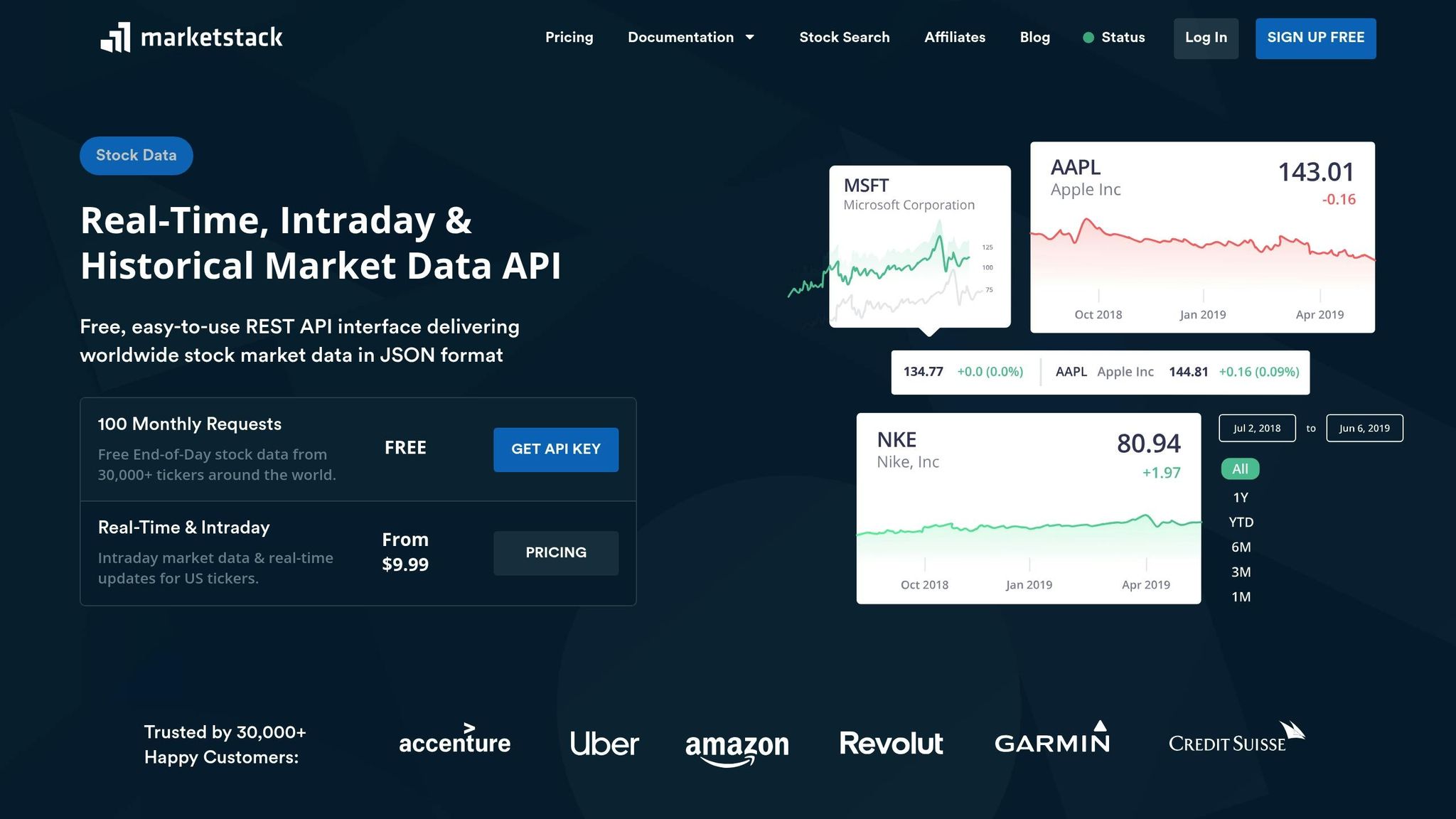
Marketstack is a financial data API designed to provide insights into equity markets, commodities, bonds, and ETFs. However, it lacks historical options data, which might be a dealbreaker for traders needing detailed options history.
Data Coverage
Marketstack’s API includes historical data for over 500,000 stock tickers from more than 2,700 global exchanges, offering up to 15 years of end-of-day data on its Professional plans. It also covers historical prices for more than 70 commodities, spanning categories like energy, metals, industrial goods, agriculture, and livestock. The range of historical data varies by commodity, from 9 to 15 years. Additionally, Marketstack provides data on 750+ major global stock market indices, along with historical records for stock splits, dividends, and ETF holdings [16–19].
Granularity
For supported instruments, Marketstack delivers end-of-day data. It also offers intraday data for U.S. stock tickers listed on the IEX exchange. This intraday data can be as granular as one-minute intervals and includes up to 10,000 historical entries per interval on Professional plans.
Pricing Structure
Marketstack uses a tiered subscription model, offering Basic and Professional plans. Higher-tier subscriptions provide access to longer historical data periods and more detailed intraday information.
Next, we’ll explore how Stock Analysis offers another way to access historical market data.
7. Stock Analysis
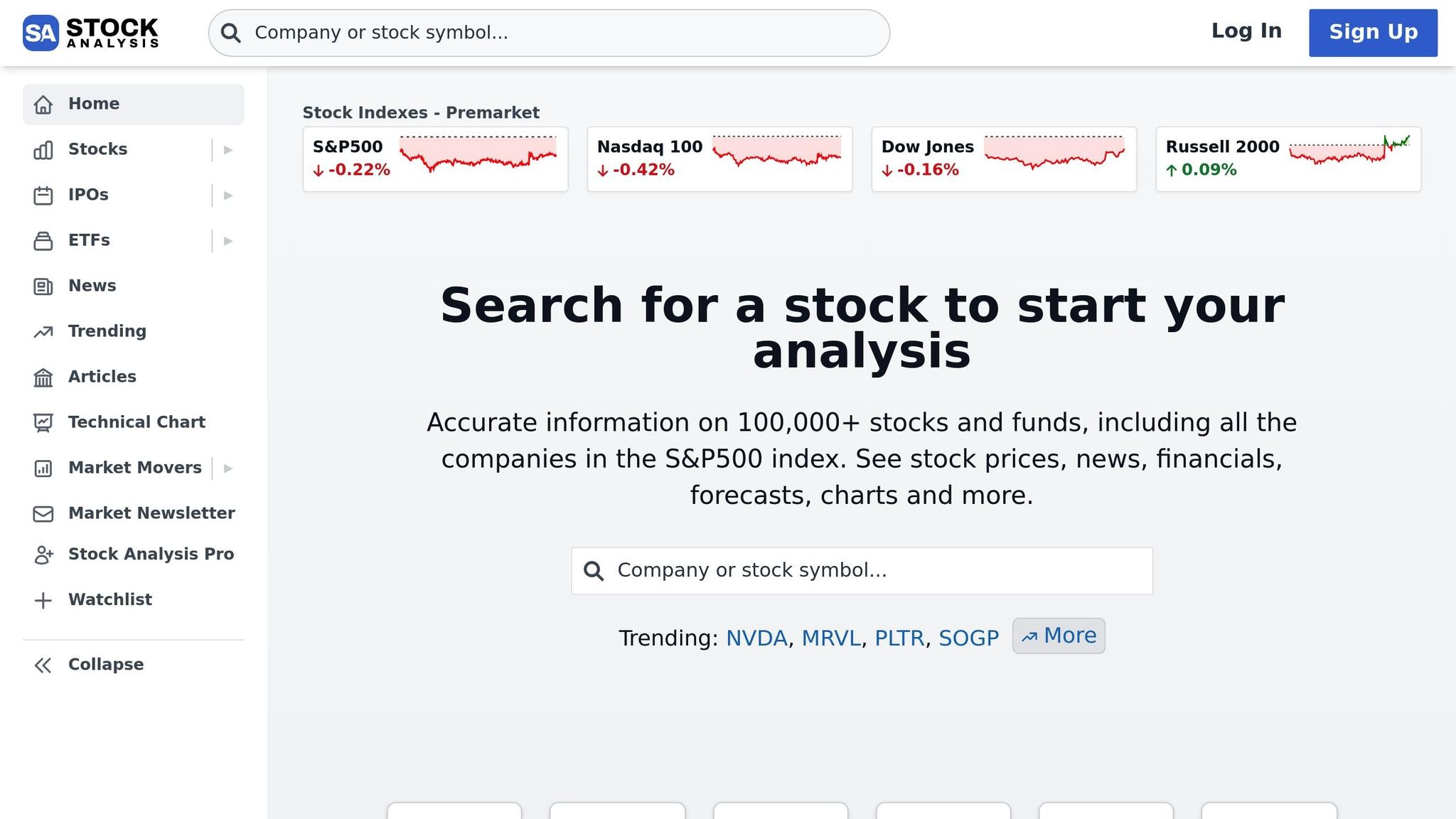
Stock Analysis leans heavily toward equity research, offering a straightforward platform for exploring U.S. stock market data. Its focus is less on in-depth historical options analytics and more on making stock-related information accessible through an easy-to-navigate interface.
Data Coverage
The platform provides historical data for U.S. stocks, along with basic price histories for publicly traded companies. While you might find some options-related data for individual stocks, it doesn’t appear to offer the kind of detailed, granular historical options data required for advanced backtesting or building automated strategies. This makes it a better fit for manual research rather than workflows that rely on automation.
Accessibility and Integration
One key limitation is the lack of API support, which means programmatic integration isn’t an option. As a free web-based platform, Stock Analysis is ideal for manual research and educational purposes but falls short when it comes to large-scale automated analysis.
For a deeper dive into how this platform stacks up against others, explore the upcoming feature comparisons to find the right solution for your needs.
Feature Comparison Table
When selecting a data provider for options trading or analysis, it’s crucial to consider factors like data coverage, granularity, pricing, and API integration. The table below provides a quick overview of key providers, helping you identify the best fit for your needs.
| Data Source | Options Coverage | Data Granularity | Pricing Model | API Access | Best For |
|---|---|---|---|---|---|
| Finnhub | U.S. options chains, both real-time and historical | Tick-level, minute, and daily data | Freemium model with free and paid plans | REST API, WebSocket | Real-time integration and automated trading |
| OptionMetrics | Global options markets with extensive historical data | Daily snapshots and end-of-day data | Enterprise pricing with custom quotes | Institutional APIs and bulk download options | Academic research and institutional analysis |
| Databento | U.S. equity and futures options | Tick-by-tick, high-frequency data | Usage-based pricing | High-performance APIs supporting multiple protocols | High-frequency trading and backtesting |
| EOD Historical Data | U.S. options with limited international coverage | End-of-day data with some intraday intervals | Subscription-based pricing | REST API and bulk CSV downloads | Cost-effective research and small-scale analysis |
| Polygon.io | U.S. options chains with real-time feeds | Tick-level and aggregated bars | Tiered pricing with free access options | REST API and WebSocket streaming | Developer-friendly integration for medium-scale projects |
| Marketstack | Primarily equities data with limited options coverage | End-of-day data | Subscription-based pricing with a free tier | REST API | Basic research and educational purposes |
| Stock Analysis | Minimal options coverage | Basic historical price data | Free web platform | No API support | Manual research and educational use |
Key Takeaways
- Data Depth and Precision: Providers like Databento deliver tick-level precision, ideal for high-frequency trading and backtesting, while OptionMetrics emphasizes comprehensive daily analysis for academic and institutional needs.
- Pricing Models: Pricing varies significantly. OptionMetrics caters to enterprise clients with custom quotes, whereas Finnhub and Polygon.io offer scalable freemium models, making them accessible to developers and smaller teams.
- API Access: API capabilities are a major differentiator. Platforms like Databento and Polygon.io integrate seamlessly into automated systems, enabling efficient workflows. Conversely, Stock Analysis lacks API support, which limits its utility to manual data collection.
- Geographic Focus: U.S. options data is well-represented across most providers, but those needing global coverage may find OptionMetrics better suited to their needs.
Conclusion
When choosing a historical options data provider, it’s essential to align your choice with your specific trading goals, technical requirements, and budget. Take a close look at factors like the level of detail in the data, how easily it integrates with your systems, and the geographic scope of the coverage. Some platforms are tailored for high-frequency trading, while others are better suited for academic or analytical purposes.
Whether you need deep archives of historical data or a simpler, more efficient access method, focus on a provider whose retention policies, integration options, and pricing align with your priorities. This approach ensures you get both reliable performance and good value for your investment.
FAQs
What should I look for in a provider when downloading historical options data?
When choosing a provider for historical options data, prioritize accuracy, depth, and coverage. These elements are crucial for effective backtesting, thorough research, and building strategies that work. High-quality data forms the backbone of informed trading decisions.
Beyond the data itself, think about practical aspects like ease of access, pricing, and compatibility with your trading systems. These factors can streamline your workflow and help manage costs. Having detailed, easily accessible data at your fingertips not only saves time but also improves the overall efficiency of your analysis.
How should I evaluate pricing models for historical options data as a small-scale researcher or institutional client?
Pricing Models for Historical Options Data
When it comes to historical options data, pricing models can differ significantly, so finding one that matches your goals and budget is key. For small-scale researchers, flexible options like pay-as-you-go plans or low-cost subscriptions are often the best fit. These choices provide access to the essential data needed without requiring a hefty upfront expense.
In contrast, institutional clients usually lean toward enterprise or bulk licensing agreements. These arrangements offer access to extensive datasets at negotiated rates, making them ideal for large-scale backtesting and long-term research projects. While comprehensive data packages can exceed $1,500, institutions with larger budgets are better equipped to handle these costs compared to smaller users, for whom such pricing might be a hurdle.
To choose the right pricing model, weigh factors like how much data you need, how often you’ll use it, and what your budget allows. This will help you identify the most cost-effective solution for your specific requirements.
What are the main differences in data granularity and API access among the top historical options data providers discussed in the article?
The leading historical options data providers in 2025 stand out based on two key factors: data granularity and API access. Some platforms cater to users needing intricate details, offering tick-level data with order book snapshots and trade-specific information. Others focus on broader datasets, delivering daily summaries or multi-decade historical overviews. This range of options ensures that users can find a solution tailored to their needs, whether they’re engaged in high-frequency trading or conducting long-term backtesting.
API access is another area where providers differ. Many platforms offer robust RESTful APIs that support multiple programming languages, making it easier for developers to integrate them into their systems. While some APIs are built for real-time data streaming, others are optimized for pulling historical data. Additionally, certain providers prioritize compatibility with U.S. trading systems and exchanges, ensuring they cover domestic markets comprehensively.
Ultimately, your choice of provider will depend on what you value most – whether that’s highly detailed, real-time data or extensive historical insights – and how seamlessly their API fits into your workflow.








